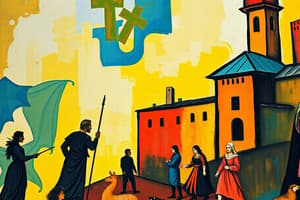Podcast
Questions and Answers
What style of architecture replaced Romanesque architecture around 1150?
What style of architecture replaced Romanesque architecture around 1150?
- Gothic (correct)
- Byzantine
- Romanesque
- Renaissance
What were the primary reasons for the construction of cathedrals in the Middle Ages?
What were the primary reasons for the construction of cathedrals in the Middle Ages?
- To express religious faith and serve as centers of learning (correct)
- To demonstrate the power of the monarchy and showcase national wealth
- To house secular courts and government offices
- To provide a secure means of storage for vital documents and valuables
Which of the following features distinguishes Gothic cathedrals from Romanesque churches?
Which of the following features distinguishes Gothic cathedrals from Romanesque churches?
- Flying buttresses and stained glass windows (correct)
- Rectangular shape and long, rounded ceilings
- Barrel vaults and thick pillars
- Small windows and limited light
How did the Crusades and the rise of strong governments impact medieval European culture in the 1100s?
How did the Crusades and the rise of strong governments impact medieval European culture in the 1100s?
What were medieval students expected to study at universities?
What were medieval students expected to study at universities?
What does the word "scholasticism" refer to?
What does the word "scholasticism" refer to?
Which of the following cities was home to one of the first medieval universities?
Which of the following cities was home to one of the first medieval universities?
What was Anselm known for?
What was Anselm known for?
How did stained glass windows in Gothic churches contribute to their religious significance?
How did stained glass windows in Gothic churches contribute to their religious significance?
Why were books rare in medieval universities?
Why were books rare in medieval universities?
Flashcards
Role of Religion in Government
Role of Religion in Government
Refers to how religious beliefs influence governmental policies and laws.
Medieval Architecture
Medieval Architecture
Architecture during the Middle Ages, often characterized by churches like Romanesque and Gothic styles.
Romanesque Style
Romanesque Style
An architectural style featuring thick walls, small windows, and rounded ceilings used in early medieval churches.
Gothic Style
Gothic Style
Signup and view all the flashcards
Flying Buttress
Flying Buttress
Signup and view all the flashcards
Development of Universities
Development of Universities
Signup and view all the flashcards
Curriculum in Medieval Universities
Curriculum in Medieval Universities
Signup and view all the flashcards
Scholasticism
Scholasticism
Signup and view all the flashcards
Anselm of Canterbury
Anselm of Canterbury
Signup and view all the flashcards
Impact of Crusades
Impact of Crusades
Signup and view all the flashcards
Study Notes
European Culture in the Middle Ages
- Medieval Europeans grew more confident and secure due to the Crusades and strong governments.
- Trade, banking, and businesses thrived, leading to more money for buildings and learning.
- Architectural styles evolved. Romanesque churches, characterized by thick pillars, heavy walls, and barrel vaults, were common in the 1000s and 1100s.
- Gothic churches (starting around 1150) featured flying buttresses (stone arches), thinner walls, spacious interiors, and large stained glass windows.
- Religious structures were a central focus for medieval societies, with architects building churches and cathedrals.
- Cathedrals were constructed by various figures, including clergy, merchants, and nobles.
Development of Universities
- Medieval universities originated in the Middle Ages, with universities established in Bologna (Italy) and Paris (France).
- Oxford and Cambridge universities emerged later in England.
- By 1500, Europe boasted roughly 80 universities.
- Universities served as centers for education and training.
- Students studied a range of subjects, including grammar, public speaking, logic, arithmetic, geometry, music, and astronomy.
- Educators utilized texts and discussions, where students took notes on small, portable slates.
- Obtaining a degree typically involved oral exams over several years, culminating in a doctorate. Law, medicine, and theology were popular degree options.
Scholasticism
- Scholasticism was a new way of thinking that emerged around 1100.
- Followers of scholasticism aimed to show philosophical ideas, accepted based on faith, were compatible with reason.
- Anselm, serving as the archbishop of Canterbury from 1093 to 1109, was a prominent early scholastic thinker.
- His reasoning was a key aspect of early scholasticism, particularly focused on the existence of God.
Studying That Suits You
Use AI to generate personalized quizzes and flashcards to suit your learning preferences.



